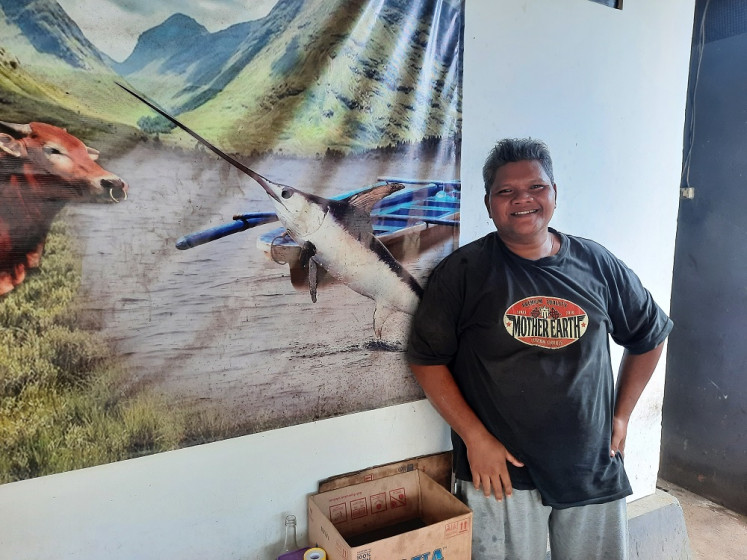The controversial delicacy taking Bali by storm
Change text size
Gift Premium Articles
to Anyone

A
small warung (stall) serving lawar empas (freshwater softshell turtle) is gaining popularity in Bali. But troubling questions linger about the dish’s inspiration and provenance.
There’s nothing unusual about the scenes that greet you when you step into Adi Dongker’s warung (stall). Located near an art market in the sleepy hamlet of Sukawati – 30 minutes from the Denpasar city center – the eatery is typically thronged with excited foodies.
With his imposing knife and extensive spice rack, Adi’s warung has slowly gained acclaim among connoisseurs of one of Bali’s most beloved dishes: lawar.
A catch-all term for coarsely chopped spices, condiments, and meats thickened with either coconut milk or spiced blood, lawar is enhanced with a protein – often pork or duck.
It may not have the global clout of rendang (Padang spice-braised meat), nasi goreng (fried rice) or the fame of Balinese babi guling (spit-roasted suckling pig), but for the islanders, lawar is a way of life. Literally.
Its presence at traditional ceremonies, weddings and religious rituals is unnegotiable. Village elders and religious leaders alike request different lawar for different rituals and occasions, and making it is a village affair. At its best, lawar is a celebration of each Balinese region’s unique terroir, culture and wisdom.
Over at Adi Dongker’s place, though, a new type of lawar has gained popularity, while harkening back to a controversial past.
“This is evocative of an old-school obsession,” Adi said. “Memories of this dish are close to Balinese hearts, but since the prohibition, it’s been harder to revisit.”
A simple paper sign announces the warung’s specialty: lawar empas (freshwater softshell turtle lawar).

Controversial legacy
Improbably enough, this deeply traditional dish regained its popularity through YouTube.
“Earlier this year, I was watching a video by Bobon Santoso,” Adi recalled, referring to a popular celebrity chef known for his outlandish food stunts.
“And he was cooking this thing he called labi-labi in Singkawang, West Kalimantan. When I saw what he pulled out, I was shocked.”
Known in Bali as empas and in the rest of the archipelago as labi-labi or bulus, the Asiatic softshell turtle is commonly found in the rivers of Kalimantan, Sumatra and Bali.
“I thought, if he’s cooking this and putting it out on YouTube for millions to see, then it must not be endangered,” Adi said. “I started doing my research.”
He found a cottage industry acknowledged and tolerated – if not openly encouraged – by the government, with labi-labis being bred specifically for consumption in places as far away as Central Java.
Though several species of freshwater softshell turtle are considered endangered by The International Union for Conservation of Nature (IUCN), as a whole, trading and breeding labi-labi in particular is legal in Indonesia.
Less commonly spotted in the polluted rivers of Java, labi-labi are still plentiful in Kalimantan and Sumatra, where they’re prized for their supposed medicinal purposes.
Adi began scouring social media for labi-labi hunters in Bali, eventually settling on a “hobby fishing community” on Facebook.
“They’re mostly part of the Muslim diaspora in Karangasem who hunt for eels, and labi-labi are bycatch,” Adi said.
The hunters set traps on tree trunks at bends in rivers, leave them for the night and sort through whatever’s caught the next day. As labi-labi are not a common part of the community’s diet, the turtles are often thrown back to the rivers — sometimes with allegedly disastrous results.
“The hunters told me that these labi-labi would invade irrigation canals and even tear through cement to make homes,” Adi said. “So they started hunting them more frequently because they considered them pests. But they didn’t know what to do with all these turtles.”
Adi Dongker asked the hunters at Karangasem to sell the turtles to him instead of chucking them into a fire, which they gladly did at a low price. As the turtles are mostly by-catch, the yield is uncertain. On bad weeks, 5 kilograms of young, barely edible turtles will cause the chef headaches. On good weeks, though, 25 kg of turtles will arrive and be sold out in a few days.
Though it’s also rarely consumed in Bali, labi-labi makes the occasional appearance at certain religious ceremonies.
“If we’re asked to present an offering called Isin Tukad — literally, ‘the river’s bounty’ — sometimes labi-labi sate appear alongside freshwater fishes and crabs.”
However, Adi acknowledged that the main inspiration for his latest dish came from a more controversial past.
For hundreds of years, the Balinese regularly consumed sea turtles — most of which ended up chopped up and spiced in lawar.
“Most Balinese, especially on the southern coast, would consume sea turtles as offerings or part of religious ceremonies and weddings,” said I Made Sukanta, head of the Turtle Conservation and Education Center (TCEC) in Serangan, a major fishing hub in Bali.
“It’s especially significant as an offering for full moon ceremonies.”
However, as time went on, sea turtles made their way out of the temples and into restaurants and dining tables.
“By the 1990s, 20 percent of fishermen in Serangan were specialized sea turtle hunters,” Sukanta said.
“The hunters started coming in from Java and Sulawesi, and they all hunted the turtles all over the archipelago. There were even large scale markets and merchants selling the meat all over Bali.”
As a young boy, Adi recalled that sea turtle meat was easier to find in coastal cities than chicken or pork. Prized for its delicate flavor, distinctive texture and its seemingly endless supply, the soaring demand and wild hunting pushed the sea turtle’s population to the brink.
In 1999, the government declared all species of sea turtle protected, and banned hunting and consumption of the animals. Exceptions were made for special religious ceremonies, and a letter had to be personally sent by the Indonesian Hindu Dharma Association (PHDI) to the government for approval.
Sukanta estimated that 1 out of 10 sea turtles bred in captivity were “repurposed” for consumption in religious rituals — mainly for coastal communities and only for especially significant ceremonies.
A strong education campaign and crackdown on black market dealings has gradually replenished the animal’s population in the wild.
“It’s been a decade-long struggle,” Sukanta said. “But we’ve gradually been able to wean people off of sea turtles and [have redirected them to] chicken or pork instead.”

Reliving the past
As Adi Dongker discovered, though, there is no ingredient more potent than nostalgia. When he ordered his first batch of labi-labi, he found its texture and taste very similar to sea turtle — but with a key difference.
“Freshwater turtles taste less fishy than sea turtles,” he said. “So you’re able to be more subtle with the spices and allow the spice blend’s complexity to come through.”
His style of lawar is particular to this stretch of coastline on Gianyar, the eastern part of Bali. Often called lawar plek, it’s mostly made from raw fish (mostly marlin), mixed with the distinctive spice blend bumbu rajang, then topped with green peppercorns.
Subtly spicy, citrusy and smoky, a proper plate of lawar plek tastes like ceviche that has grown up.
“My spice mix is particular to Sukawati,” Adi said. “It’s coarsely cut, instead of ground or pounded.”
A who’s who of spices make an appearance in his distinctive paste, including galangal, cutcherry, chili, ground coriander seeds, palm sugar, shallots, nutmeg fruits and many more. To compensate for its chewy texture, he parboils the turtle instead of serving it raw, slicing it thin and taking care to incorporate different parts of the animal into the lawar.
Adi’s serves the freshwater turtle four different ways — including as a sate and coarsely ground in a chilled soup. The meat itself is surprisingly subtle in taste and is more of a study in texture than an explosion of meat juice and flavor.
Though the meat will inevitably spark the most heated dinner table conversations, the hero of the story is the spice mix. Complex, summery and not at all fiery, it’s a surprisingly accessible introduction even for lawar novices.
For Adi, a plate of lawar empas is a window to the past, and a safe way to conserve a controversial culinary legacy.
“People come here to evoke nostalgia about sea turtle lawar,” he said. “That was part of the culture for people on the coasts.”
As our conversation drew to a close, a family of four stepped into Adi’s warung and confidently ordered a serving of lawar empas. The father, a man in his late 30s, let out a full belly-laugh as he sampled the dish, before insisting that his young son try some too.
Much to Adi’s satisfaction, the son gulped down a spoonful of lawar empas, decided he loved it, and pulled the plate to his side of the table.









